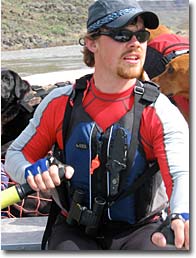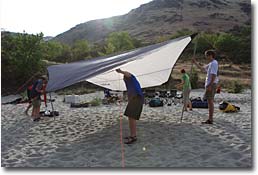How Sun Protection Works
Does it seem magical that you can smear a liquid or gel on your body and have it protect you from a painful sunburn? Well, there’s no magic, but there is a hefty dose of chemistry and/or physics involved.
How do they work?
Sun protective skin care products fall into two basic categories (or a combination thereof): Ones that physically block or scatter the sun’s rays, sometimes referred to as “sunblocks”, usually contain zinc oxide or titanium oxide. Sometimes these sunblocks form a visible white barrier on the skin surface.
Sunscreens, as a general category, rely on chemical compounds that absorb ultraviolet radiation (UV) and dissipate it in the form of heat energy. Your body actually has a faint red glow, which you can't see when you're out in bright sunlight!

What is ultraviolet radiation?
It is radiation that comes from the sun or from artificial sources like tanning beds and sun lamps:
- UVA is the longest wavelength. It isn’t absorbed by the earth’s ozone layer and penetrates deeper into the skin than UVB. It is responsible for premature aging of the skin and causes damage that can lead to skin cancer.
- UVB is the wavelength that causes sunburn and is partially blocked by the ozone layer. It too causes skin damage that can lead to cancer.
- UVC is totally blocked by the ozone layer. Here on earth we can only be exposed to it from artificial sources… but astronauts must beware.
What is the SPF number you see on sunscreens?
SPF is the acronym for Sun Protection Factor. It’s a measurement of how long you can stay in the sun without burning when using a particular sunscreen. If when unprotected, you normally burn after 20 minutes in the sun and you use an SPF 15 rated sunscreen, theoretically you are protected for 300 minutes (20 x 15 = 300).
As you can imagine, this is a laboratory test. On day one, an untanned person has a portion of their unprotected lower back exposed to artificial UVB rays. The length of time it takes for the skin to redden is recorded. The next day, a different area of the back is coated with the sunscreen being tested and the length of time until redness is recorded. The ratio of these two numbers is the product’s SPF rating. On the second day, the test subject probably gets paid for taking a nap.

Is an SPF 30 sunscreen twice as effective as an SPF 15?
No. An SPF 15 sunscreen blocks approximately 93% of the sun’s rays and an SPF 30 blocks 97%. However, since most people don’t apply the recommended amount of sunscreen, the higher SPF formulations can offer better real-world protection.
So how do you protect yourself from UVA radiation? Select sunscreens that say they protect against both UVA and UVB, or bill themselves as “broad spectrum”. This is no guarantee, since there are no standards for UVA protection, but it can’t hurt. We’ll talk about other protective measures later.
How much sunscreen should you apply and how often?
Studies show that most people apply only 25-50% of the recommended amount. The American Academy of Dermatology and others say that about one ounce (a shot glass full) is needed to cover most people wearing just a bathing suit.
Apply it 15–30 minutes before going into the sun, apply it liberally and thoroughly rub it in. Most recommend a reapplication about every 2 hours, especially if you are sweating, swimming or getting splashed while boating.
Can I still use the sunscreen I bought last summer?
Unless a sunscreen container has an expiration date on it, it is required to be stable enough to keep its protective value for three years. But remember, sunscreen needs to be applied liberally and many people don’t use the recommended amount. If you’ve got sunscreen left over, maybe you’re not putting on enough.

What is a sunburn and is there a healthy way to tan?
There is no healthy way to tan, at least tanning from the sun or tanning parlor sources. Tanning is the body’s natural response to damage caused by UV radiation. The body responds to this damage by increasing blood flow to the affected area in order to bring in cells to help repair the damage. The extra blood in the capillaries of the upper skin layers is what you see as the redness we call “sunburn”.
And remember, UVA radiation does not create visible sunburn. In the short term, its damage is invisible. In the long term, its deep penetration causes aging of the skin (the leathery, wrinkled, spotted look) and severe damage that can lead to skin cancer.
Okay, how can I fully protect myself from UV damage?
The very best way is to stay out of the sun. Duh. But since you’re reading this, you’re likely an outdoors person and probably a boater. So, Plan B.
The sun’s rays are most intense from 10 am to 4 pm. Take special care to protect yourself during this time period.
Consider wearing sun protective apparel as much as possible when outdoors. The efficiency of this kind of clothing is rated as its Ultraviolet Protection Factor (UPF). A UPF of 45 means that only 1/45th of the UV rays that strike it will penetrate it. UPF 50+ is the highest rating given. You’re constantly protected in the areas covered by sun protective apparel; there’s no need to apply and reapply sunscreen. Wide brim hats really help shade your head, face and neck. These are some of the more exposed and sensitive areas of the body. Even if you don’t need gloves for palm protection while boating in the summer, wearing them gives the backs of your hands much needed protection.
As we said earlier, choose a broad spectrum sunscreen, or one that says it protects against both UVA and UVB radiation, with at least an SPF 15 rating. Apply it liberally and often, at least every 2 hours. Pay particular attention to the ears, shoulders, back and backs of the knees and legs.
Use extra protection around water, light sand and snow: they reflect the sun’s rays and intensify its effect. Kids can’t protect themselves; it’s your job to make sure they have on lots of sunscreen and protective clothing and play in the shade when possible.
Probably most of all, we need to lose the notion that a tan makes us look healthy, sexy and cool. Join the anti-tan generation – you’ll truly stay healthier and happier in the long run!
Boat Often & Boat Safe